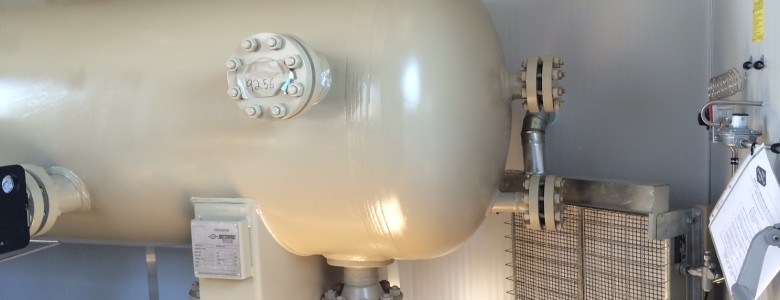Pressure vessels, such as the ones used in the oil and gas industry, are rated with a Maximum Allowed Working Pressure (MAWP). If this pressure is exceeded, the equipment can be seriously damaged or worse, an explosion or a fire or a combination may be the result. Keeping field workers safe is a priority so adhering to the MAWP critical to safe operations and providing a safe work environment.
One of the ways to protect pressure vessels ensuring production vessels are equipped with pressure safety valves (PSV). Each PSV is designed for a specific purpose. An example of a PSV in everyday use is the whistle on a steam kettle. When water boils, the pressure inside the kettle builds up to the point where the kettle whistles. The same happens inside a separator or similar vessel.
Why does pressure build up?
There are many reasons why pressure can build up including:
- Overheating in a treater;
- A well “pressuring up” due to a slug of gas;
- A slug of gas making its way down a pipeline to a vessel.
According to Todd Oliphant, Manager at Tyco Black & Gold Valve in Calgary, provider of valves and fittings for the oil and gas industry, there are three types of PSVs.
“First there is the PRV, or the Pressure Relief Valve. These valves modulate opened and closed as the system pressure increases and decreases. These have one adjusting ring and do not have an audible ‘POP’ when they overpressure.”
Oliphant describes the second type of valve as,
“Automatic pressure relieving devices actuated by static upstream pressure. They are used for air and steam service and usually have two adjusting rings and a lift lever on top of them. These valves make an audible ‘POP’ sound when they give way.”
According to Oliphant, the last type of safety value is,
“The PRV, or the Pressure Relief Valve. They’re automatic, and are operated by upstream pressure. PRV’s are designed to prevent a rise of system pressure above a specified value and to re-close after normal conditions are restored.”
The pressure release valve
PRVs are designed to prevent a rise in system pressure above a specified value to re-close after normal conditions are restored.
In the case of the PRV, “Protection comes from a valve designed to be normally closed due to resistance on it by a spring’s force. As vessel pressure gets closer to the pressure set on the PSV, the pressure tends to equalize the spring’s force, and (in vapor or gas service) the valve may “simmer” before it will ‘pop’.
When the vessel pressure increases to within one to two per cent of the set pressure, gas will start to move past the valve’s seat surfaces fast enough that you can hear it escaping. A proper PSV therefore lets pressure gradually build when pressure builds up close to the MAWP of the vessel before it “pops” fully open,” explains Oliphant.
PSVs can be used in one of three situations:
- In single valve installations
- Multi valve installations
- Fire-size installations
Single valve installations
Use a single valve installations one valve must relieve the entire system. ASME code dictates that valves should be set no higher than, but may be set lower than, the MAWP. This involves calculating valve relieving capacity.
Calculating the valve relieving capacity needs to be determined for specific needs and it’s advisable to have a professional determine this.
Multi-valve installations
Multi-valve installations are often used as it is less expensive to fit two smaller PSV’s than a single larger unit. This may cause the end-user to spend more on piping the PSV’s, but it also adds an additional measure of safety due to the built-in redundancy.
The key is that both valves must be in unrestricted communication with the vessel they are designed to relieve. Multi-valve installations also allow one relief valve to be set no higher than MAWP, while subsequent valves may be set at five per cent above MAWP.
Fire-sizing installations
Oeltsje Kalsbeek at Tartan Engineering is an expert on fire-sizing. Installation of fire sizing is complicated since a battery fire goes through a number of steps. For example, a heated crude oil treater may first contain gas, oil and water. However, light a little fire underneath that treater, instead of in the firetube, and eventually first the lighter ends will boil, then the other hydrocarbons might boil, and finally the water. Each of these happens at different stages of the fire. This means that different quantities of material can be projected from the relief valves at different times.
ASME dictates that fire-sizing involves multiple valve installations, and must be in unrestricted communication with the to-be-protected system. The allowable over-pressure for fire-sizing considerations is 21 per cent above MAWP. These valves because will have an ASME symbol stamped nameplate reflecting the individual valve set pressure and the relieving capacity at 10 per cent overpressure. In addition, a fire-sized valve will have another nameplate, without the ASME symbol, which reflects valve set pressure and calculated capacity at its particular overpressure.
When determining fire-sizing requirements it is important to use valves already selected for operational overpressure conditions. Fire-sizing should be considered as an emergency situation, and any fire-sized valve relieving requirements should only be in addition to those already selected.
Summary
There is a lot more to these valves, such as specific codes, identifying these PSV’s as suitable for use in power boilers (ASME Sec. 1), unfired pressure vessels (Sec. VIII), and those used in heating plants (Sec. IV). The PRV is the first line of safety, and the last line of defense for the protection of personnel, plant equipment, and property from dangerous overpressure conditions.

